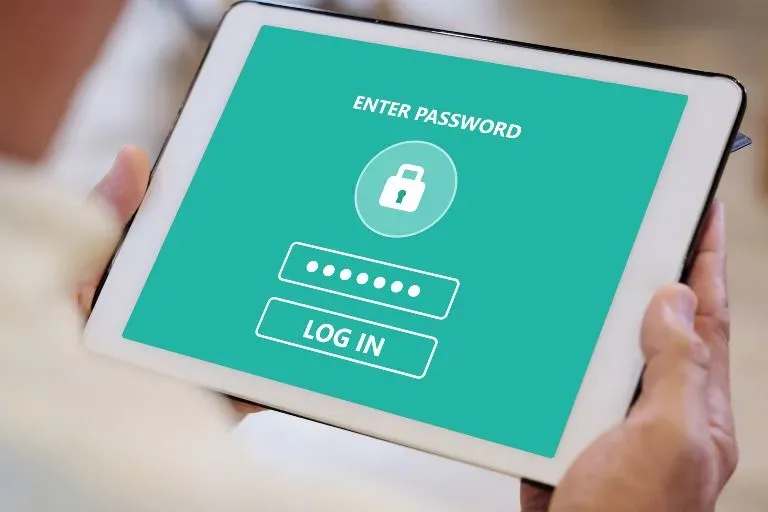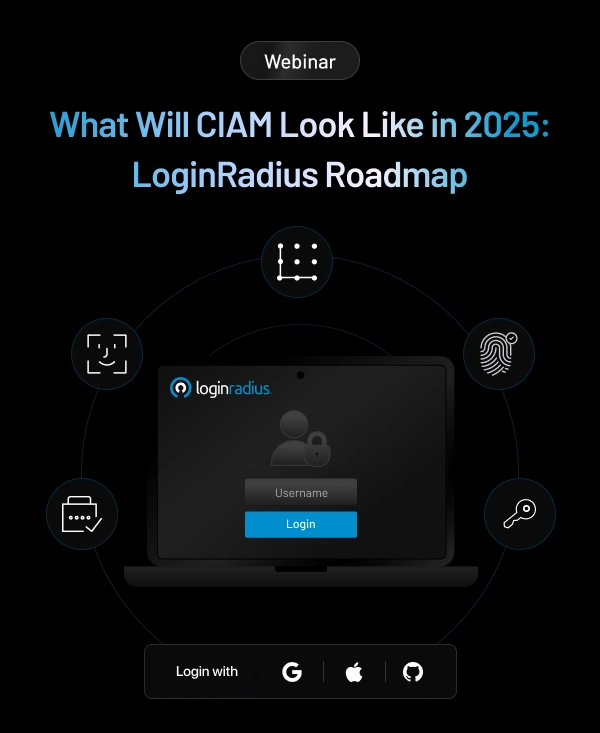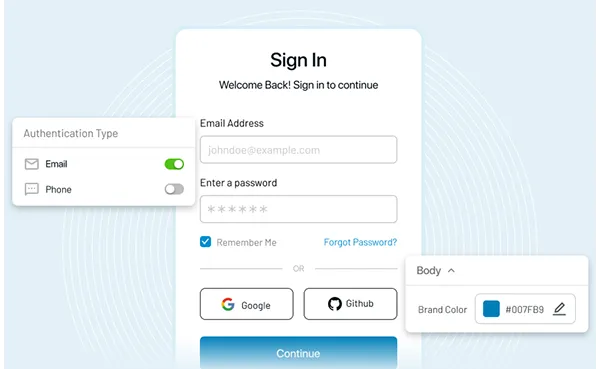Introduction
Passwordless login verifies consumer identities without using passwords or any other memorized credentials.
The consumer is confirmed with the help of a possession factor, which can be an object that uniquely identifies the user with an email (link) or SMS (OTP) sent to the registered email address or phone number, respectively.
Once the link or OTP is verified, the consumer will be logged into the account. Let’s uncover the aspects of passwordless access and how it paves the way for overall business success.
Why Should You Use Passwordless Login?
Passwordless Login makes life easier as you do not need to remember different passwords anymore.
Can you exactly recall which accounts what passwords belong to? How frequently do you reuse the same password because you can't have a unique, strong, and easily-remembered password for each of your accounts?
Passwordless Login takes the frustration out of the equation to create a better consumer experience.
How Does Passwordless Login Work?
We’ve learned why you should embrace passwordless login. Now, let’s learn how does passwordless login work.
Passwordless login is an innovative authentication method that enhances security and user experience by eliminating the need for traditional passwords.
Instead of relying on a combination of characters that users must remember, passwordless login leverages various alternative factors for authentication. These factors can include biometrics like fingerprint or facial recognition, one-time passwords (OTPs) sent via email or SMS, hardware tokens, or authentication through social media accounts.
The process of passwordless login typically involves the following steps:
Step 1: User Initiation
When a user attempts to log in, they are redirected to the login page, where they can select the passwordless login option.
Step 2: Identity Verification
The user's identity is then verified through one of the alternative factors they choose, such as a fingerprint scan or an OTP sent to their registered email address or phone number.
Step 3: Authentication
Once the user's identity is confirmed, they are granted access to their account or the requested service or a login without password.
By eliminating passwords, passwordless login minimizes the risk of security breaches due to weak or reused passwords. Moreover, it simplifies the login process for users, reducing the chances of forgotten passwords and streamlining the overall user experience.
Real-Time Examples of Passwordless Login
Several companies and online platforms have embraced passwordless login to enhance security and provide a seamless user experience since users love login without password. Here are some real-time examples of how passwordless login is being implemented:
Example 1: Microsoft
Microsoft has integrated passwordless login options into its products and services, such as Windows Hello, which allows users to log in using facial recognition or fingerprint scans. Additionally, Microsoft's Azure Active Directory supports passwordless access for enterprise accounts, where users can receive an OTP or use a FIDO2 security key to access resources securely.
Example 2: Google
Google has introduced passwordless login options for its services. For instance, users can log in to their Google accounts using their mobile devices' built-in biometric authentication, such as fingerprint or facial recognition.
How is Passwordless Login Useful for Business?
- It improves consumer experience, particularly mobile applications because users only need an email address or mobile phone number to sign up.
- It enhances security. Passwords are a significant vulnerability as consumers reuse passwords and share them with others. Passwords are the most significant attack vector and are responsible for a substantial percentage of breaches and attacks such as corporate account takeover, credentials stuffing, and brute force attacks.
- It reduces the total cost of ownership, as managing passwords is expensive (implementing password complexity policies, password expiration, password reset processes, password hashing and storing, breached password detection).
How to Implement Passwordless Login?
Passwordless Login can be implemented with the following method.
- Passwordless Login with Email
- Passwordless Login with OTP (SMS)
When using passwordless authentication with SMS, consumers:
- Provide a cell phone number instead of a userID/password.
- Receive a one-time-passcode (OTP) via text message (SMS).
- Enter the OTP on the login screen to access the application.
When using passwordless authentication with email, consumers:
- Provide email address or user name.
- Receive a one-time-passcode (OTP) via email or a magic link.
- Enter the OTP on the login screen or just link on the magic link which login the user.
To implement passwordless, you'll need to make two decisions:
- What will be the authentication method you want to use ( Email/SMS with one-time-passcode, or Email with a Magic Link enclosed)
- Or if you are going to implement the authentication using Embedded Login or Standard Login.
Once you have decided what kind of implementation you want, you can choose any desired solution you would require for the authentication process.
Passwordless Login with Text Message (SMS)
The consumer is prompted to enter a phone number, and the system will send a one-time-use code to that phone number via the SMS gateway. Thereafter the consumer enters the one-time passcode into your website/application.
When the phone number linked to the code verifies an existing user, the authenticator will authorize the consumer. If the consumer is new, a profile is created for the text message connection before it authenticates the consumer.
You can also configure the OTP length and the duration of its expiry for security best practices.
Passwordless Login with Email
The consumer is prompted to provide an email address, to which the authenticator sends a one-time-passcode. The consumer then inputs the code into your application. If the email address attached to the code matches an existing user, the server will identify and validate it.
If the consumer is new, then a profile is created for the email connection. This will be before the authentication authenticates the consumer. You can also configure the OTP length and the duration of its expiry for security best practices.
Passwordless Login with Magic Links
An email with a link is sent to the user. The link allows users to log in instantly just by clicking on it. It is similar to getting an email with a one-time-passcode in it. Once the user receives the code, redirects the app for authentication, and enters the code, the magic link will help to avoid these steps and authenticate directly.
The initial request for the link and response should take place in the same browser. Either the transaction will fail. So this way you will get an additional security layer with easy and simple steps.
Why Choose LoginRadius for Passwordless Authentication?
When it comes to implementing the best passwordless authentication for your business, LoginRadius emerges as a leading and reliable choice. Here are some compelling reasons why you should consider LoginRadius for passwordless login:
Robust Security
LoginRadius prioritizes the security of its users' identities. With passwordless login, the risks associated with password-related vulnerabilities are eliminated, ensuring a higher level of protection against cyber threats.
Seamless User Experience
By offering various passwordless authentication methods, including email OTP, SMS OTP, and social media login, LoginRadius streamlines the login process for users, reducing friction and login barriers.
Easy Integration
LoginRadius provides easy-to-implement APIs and SDKs, making it convenient for developers to integrate the best passwordless authentication into their applications and websites quickly.
Scalability
Whether you run a small business or an enterprise-level organization, LoginRadius' passwordless authentication solutions are designed to scale according to your needs, ensuring a smooth experience for all your users.
Compliance and Standards
LoginRadius adheres to industry best practices and complies with various security standards, ensuring that your passwordless authentication implementation meets regulatory requirements.
Undoubtedly, passwordless login offers a secure and user-friendly alternative to traditional password-based authentication. By choosing LoginRadius as your passwordless authentication provider, you can enhance your application's security, improve user experience, and stay at the forefront of modern authentication trends.
Conclusion
Now you know the security advantages of passwordless logins, you might probably be admiring what other perks implementing a similar system will have for your company or organization.
Passwordless Login provides consumers the most beneficial of both worlds: consumers can retain their payment information securely on file, preserving time in the future, and they won’t have to memorize a long, difficult password, which will prompt repeat transactions. Furthermore, your consumers are more likely to execute impulse acquisitions when the process is much easier.
Cheers!
FAQs
1. How does passwordless authentication reduce risk and improve user satisfaction?
Passwordless authentication enhances security, lessens password-related risks, and boosts user satisfaction by eliminating password complexities.
2. What are the different types of passwordless login?
Passwordless login includes biometric authentication, one-time passcodes (OTP), and hardware-based security keys.
3. How is passwordless login more secure than traditional password-based login?
Passwordless login enhances security by eliminating password vulnerabilities and reducing the risk of credential attacks.
4. What are the disadvantages of passwordless login?
Passwordless login drawbacks may include occasional device failures, privacy concerns with biometrics, and compatibility issues.
5. How can businesses transition to passwordless login?
Businesses can switch to passwordless login by integrating passwordless methods, educating users, and providing fallback options.
6. How can passwordless login improve user experience?
Passwordless login simplifies the process, reduces friction, and enhances overall user experience.
7. What is the future of passwordless login?
Passwordless login's future is promising, with advancements in biometrics, multifactor authentication, and hardware tokens driving wider adoption.
















